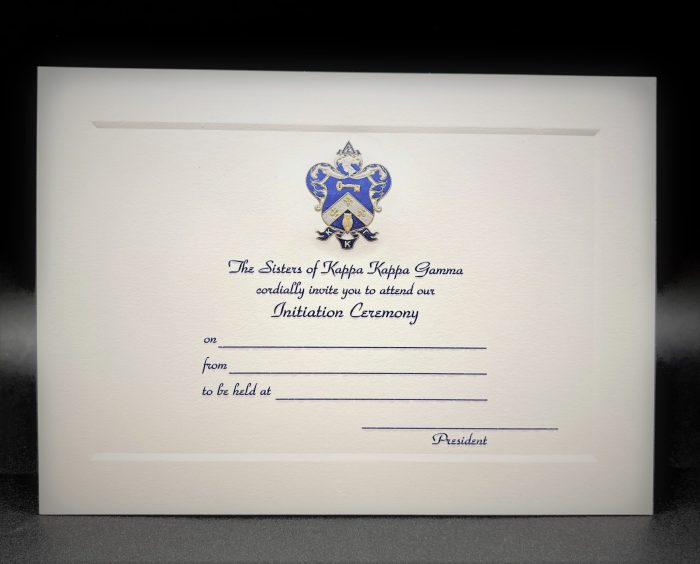The Kappa Kappa Gamma initiation ritual stands as a cornerstone of the sorority’s legacy, a time-honored tradition that has shaped countless lives. This comprehensive exploration delves into the ritual’s significance, symbolism, structure, impact, and evolution, offering a profound understanding of its enduring role within the Kappa Kappa Gamma experience.
Through a blend of historical analysis, cultural comparisons, and ethical considerations, this work unravels the intricate tapestry of the Kappa Kappa Gamma initiation ritual, revealing its profound impact on the sorority’s identity, values, and the lives of its members.
Initiation Ritual Overview

The Kappa Kappa Gamma initiation ritual holds profound significance within the sorority’s history and traditions. It serves as a sacred and transformative experience, marking the transition of new members into the Kappa Kappa Gamma community.
The ritual’s key elements include a formal ceremony, symbolic gestures, and a shared commitment to the sorority’s values. It encompasses elements of secrecy, sisterhood, and personal growth, aiming to foster a deep connection among members and a sense of belonging to a larger collective.
Purpose
The primary purpose of the Kappa Kappa Gamma initiation ritual is to induct new members into the sorority, formally recognizing their commitment to its principles and values. Through the ritual, initiates gain a deeper understanding of the sorority’s history, traditions, and expectations.
Structure
The initiation ritual is typically conducted in a formal setting, often in the sorority’s chapter house or a designated ceremonial space. It involves a series of steps and ceremonies, each with its own symbolic meaning and significance.
Symbolism
The Kappa Kappa Gamma initiation ritual incorporates various symbols and gestures that represent the sorority’s values and traditions. These symbols may include the sorority’s crest, colors, and specific rituals or actions that embody the sorority’s ideals.
Ritual Symbolism

The Kappa Kappa Gamma initiation ritual employs a rich tapestry of symbols that embody the sorority’s core values, beliefs, and aspirations. These symbols manifest through colors, objects, and gestures, each conveying a profound message.
Colors
Colors play a significant role in the ritual. The sorority’s official colors, lavender and light blue, represent loyalty and purity, respectively. Lavender signifies unwavering commitment and devotion, while light blue embodies the ideals of integrity and innocence.
Objects, Kappa kappa gamma initiation ritual
- Ivy:Ivy symbolizes enduring friendship and the intertwining of lives within the sorority.
- Candles:Candles represent knowledge, enlightenment, and the guidance provided by the sorority.
- Mirror:The mirror signifies self-reflection and the journey of personal growth and development.
Gestures
- Handclasp:The handclasp represents unity, sisterhood, and the bond shared among members.
li> Exchange of Rings:The exchange of rings symbolizes the lifelong commitment and unbreakable bond between members.
Ritual Structure and Procedures: Kappa Kappa Gamma Initiation Ritual

The initiation ritual of Kappa Kappa Gamma is a carefully structured ceremony with specific procedures and protocols that must be followed. The ritual’s order and prescribed actions are designed to create a profound and meaningful experience for the initiates, fostering a sense of unity and belonging within the sorority.
The ritual involves several key participants, each with specific roles and responsibilities. The initiate is the individual undergoing the initiation process, while the ritual leader guides the ceremony and ensures that all steps are performed correctly. Witnesses, typically senior members of the sorority, observe the ritual and provide support to the initiate.
Adherence to Ritual Order and Protocols
Adhering to the prescribed order and protocols of the ritual is crucial for several reasons. First, it ensures that the ceremony proceeds smoothly and that all participants have a clear understanding of their roles. Secondly, following the ritual’s structure creates a sense of predictability and order, which can be comforting for the initiate.
Finally, maintaining the ritual’s integrity and authenticity preserves its historical significance and ensures its continued relevance within the sorority.
Impact on Initiates
The Kappa Kappa Gamma initiation ritual has a profound impact on new members, shaping their emotional, psychological, and spiritual well-being. It fosters a deep sense of belonging, commitment, and sisterhood, while also instilling the values and identity that define the organization.
Emotional Impact
The initiation ritual evokes a range of emotions, including excitement, nervousness, and a sense of anticipation. As initiates progress through the ritual, they experience a rollercoaster of emotions, from moments of vulnerability to feelings of empowerment and accomplishment. The ritual provides a safe and supportive environment for initiates to explore their emotions and connect with their fellow sisters.
Psychological Impact
The ritual has a transformative effect on initiates’ self-perception and self-esteem. Through the challenges and revelations they encounter, initiates gain a renewed sense of confidence and self-worth. The ritual also fosters resilience and perseverance, as initiates learn to overcome obstacles and emerge as stronger individuals.
Spiritual Impact
The initiation ritual has a profound spiritual dimension, connecting initiates to the organization’s rich history and traditions. Through the use of symbols, rituals, and shared experiences, initiates develop a sense of purpose and connection to something greater than themselves. The ritual provides a framework for personal growth and self-discovery, allowing initiates to explore their spiritual beliefs and values.
Historical Evolution

The Kappa Kappa Gamma initiation ritual has undergone significant changes over time, reflecting the evolving societal norms, cultural influences, and values of the sorority. The earliest known version of the ritual dates back to the late 19th century, when the organization was founded.
This early ritual was heavily influenced by the Victorian era’s emphasis on modesty, purity, and female subservience.
In the early 20th century, as societal attitudes towards women began to change, so too did the Kappa Kappa Gamma initiation ritual. The ritual became less overtly moralistic and more focused on the development of sisterhood and personal growth. This trend continued throughout the 20th century, as the sorority embraced a more inclusive and empowering approach to its membership.
Factors Contributing to Enduring Significance
Several factors have contributed to the enduring significance of the Kappa Kappa Gamma initiation ritual within the organization. First, the ritual provides a sense of continuity and tradition for the sorority. It connects each new initiate to the women who came before her, creating a sense of belonging and shared history.
Second, the ritual is a powerful symbol of the sorority’s values. It teaches initiates about the importance of sisterhood, scholarship, leadership, and service. These values are at the core of the Kappa Kappa Gamma experience, and the ritual helps to reinforce them in the minds of new members.
Finally, the ritual is a deeply personal experience for initiates. It is a time of reflection, growth, and transformation. Through the ritual, initiates learn about themselves and their potential. They also form lifelong bonds with their fellow initiates, bonds that will last long after they graduate from college.
Cross-Cultural Comparisons

The Kappa Kappa Gamma initiation ritual exhibits both similarities and differences when compared to initiation rituals of other sororities and fraternities.
Ritual Structures
Many initiation rituals share a common structure, including a period of separation from the outside world, followed by a series of challenges and trials, and culminating in a final ceremony of acceptance.
Ritual Symbols
Symbols play a significant role in many initiation rituals, representing the values and ideals of the organization. Common symbols include candles, water, and ropes.
Ritual Purposes
Initiation rituals serve various purposes, such as fostering a sense of unity and belonging among members, transmitting the organization’s history and traditions, and testing the commitment of new members.
The Kappa Kappa Gamma initiation ritual stands out for its emphasis on personal growth and reflection. It encourages initiates to explore their own values and beliefs, and to develop a deeper understanding of the sorority’s mission.
Ethical Considerations

The Kappa Kappa Gamma initiation ritual has been the subject of some ethical concerns and controversies over the years. These concerns primarily center around the potential for the ritual to cause physical or emotional harm to initiates, as well as the issue of consent.
The sorority has a responsibility to ensure that the ritual is conducted in a safe, respectful, and non-harmful manner. This includes taking steps to ensure that initiates are fully informed about the nature of the ritual and that they consent to participate.
The sorority must also take steps to protect the privacy of initiates and to ensure that they are not subjected to any form of hazing or abuse.
Importance of Informed Consent
Informed consent is a fundamental ethical principle that requires that individuals have the capacity to make decisions about their own bodies and that they are provided with all the information necessary to make an informed decision. In the context of the Kappa Kappa Gamma initiation ritual, this means that initiates must be given a clear and detailed explanation of the ritual, including any potential risks or discomforts, before they consent to participate.
The sorority has a responsibility to ensure that initiates are fully informed about the nature of the ritual and that they consent to participate. This includes providing initiates with a written description of the ritual, as well as an opportunity to ask questions and discuss any concerns they may have.
FAQ Resource
What is the purpose of the Kappa Kappa Gamma initiation ritual?
The Kappa Kappa Gamma initiation ritual serves to welcome new members into the sorority, fostering a sense of belonging, commitment, and sisterhood. It also imparts the sorority’s values, beliefs, and aspirations, shaping the identity of its members.
How has the Kappa Kappa Gamma initiation ritual evolved over time?
The Kappa Kappa Gamma initiation ritual has evolved over time to reflect societal norms, cultural influences, and the sorority’s own evolving values. While its core elements remain unchanged, the ritual has been adapted to ensure its relevance and effectiveness in a changing world.
What are the ethical considerations surrounding the Kappa Kappa Gamma initiation ritual?
The Kappa Kappa Gamma sorority takes its ethical responsibilities seriously and ensures that the initiation ritual is conducted in a safe, respectful, and non-harmful manner. The sorority is committed to protecting the well-being of its initiates and upholding its values.